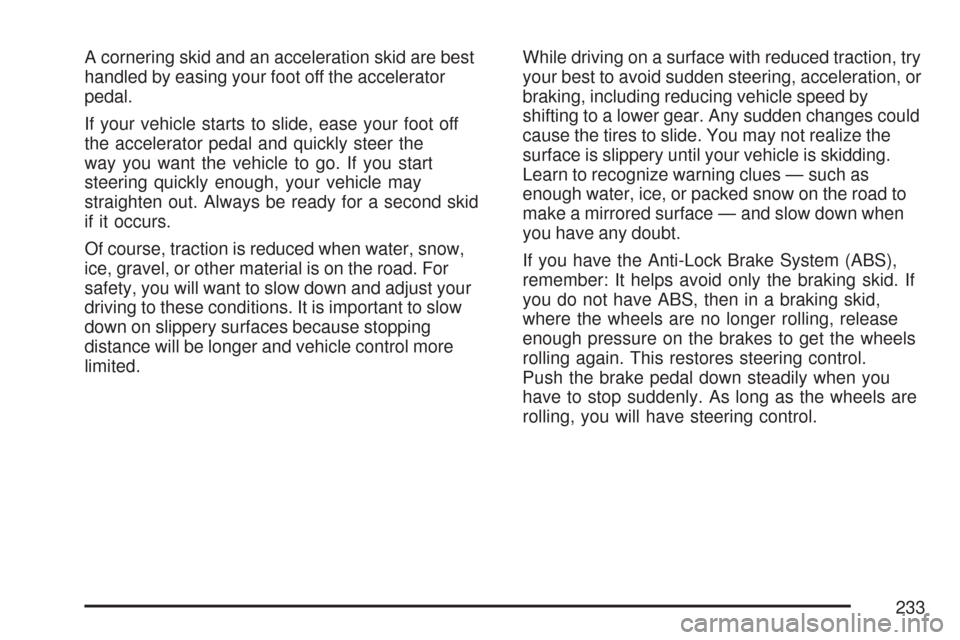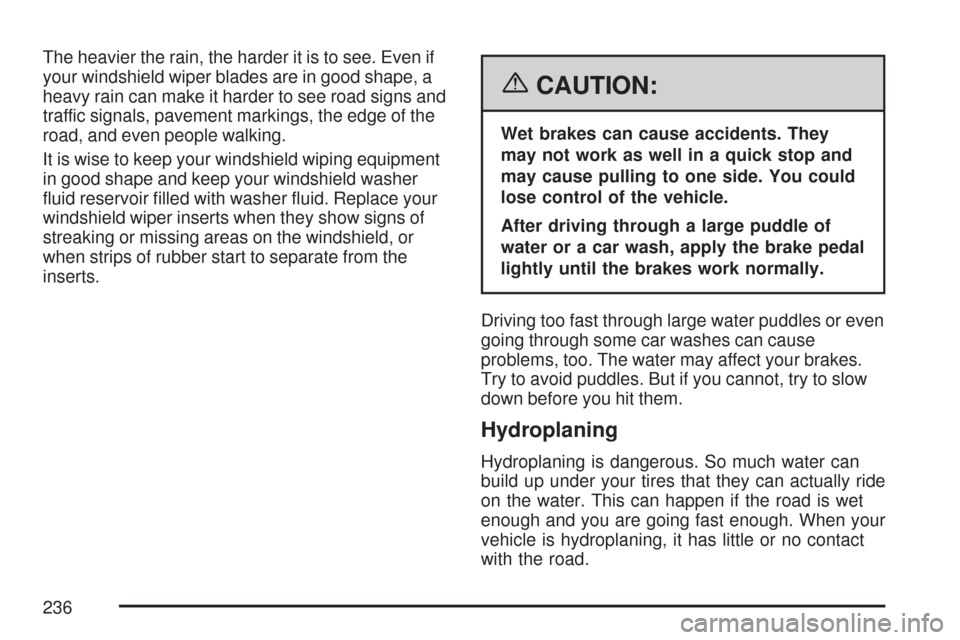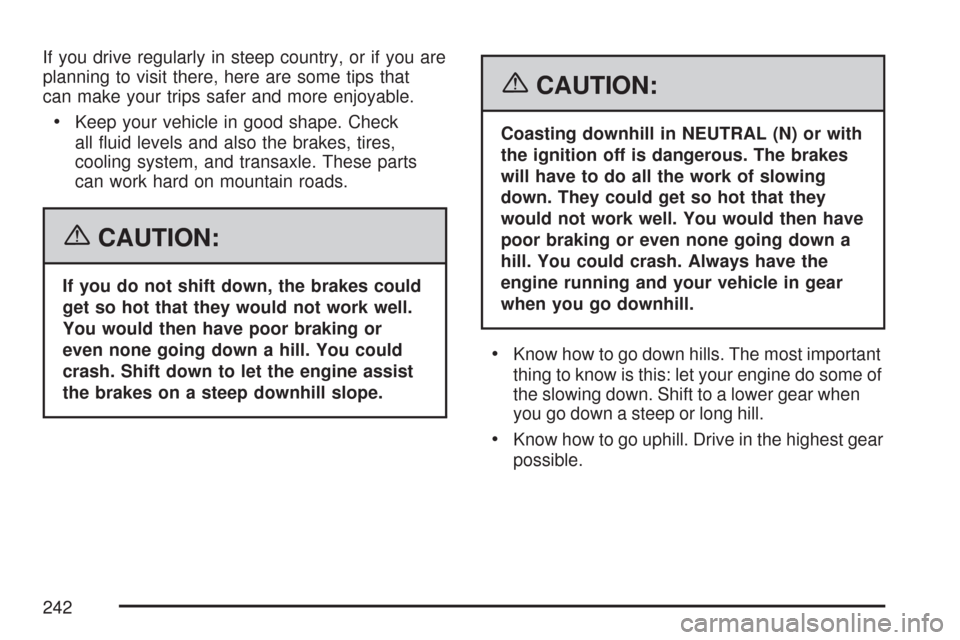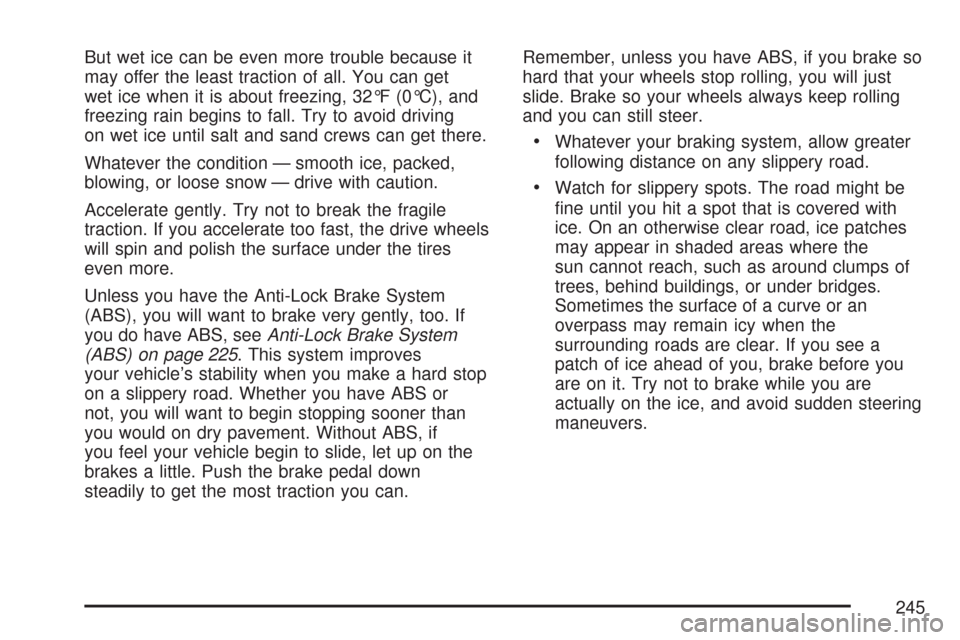Page 233 of 436

A cornering skid and an acceleration skid are best
handled by easing your foot off the accelerator
pedal.
If your vehicle starts to slide, ease your foot off
the accelerator pedal and quickly steer the
way you want the vehicle to go. If you start
steering quickly enough, your vehicle may
straighten out. Always be ready for a second skid
if it occurs.
Of course, traction is reduced when water, snow,
ice, gravel, or other material is on the road. For
safety, you will want to slow down and adjust your
driving to these conditions. It is important to slow
down on slippery surfaces because stopping
distance will be longer and vehicle control more
limited.While driving on a surface with reduced traction, try
your best to avoid sudden steering, acceleration, or
braking, including reducing vehicle speed by
shifting to a lower gear. Any sudden changes could
cause the tires to slide. You may not realize the
surface is slippery until your vehicle is skidding.
Learn to recognize warning clues — such as
enough water, ice, or packed snow on the road to
make a mirrored surface — and slow down when
you have any doubt.
If you have the Anti-Lock Brake System (ABS),
remember: It helps avoid only the braking skid. If
you do not have ABS, then in a braking skid,
where the wheels are no longer rolling, release
enough pressure on the brakes to get the wheels
rolling again. This restores steering control.
Push the brake pedal down steadily when you
have to stop suddenly. As long as the wheels are
rolling, you will have steering control.
233
Page 236 of 436

The heavier the rain, the harder it is to see. Even if
your windshield wiper blades are in good shape, a
heavy rain can make it harder to see road signs and
traffic signals, pavement markings, the edge of the
road, and even people walking.
It is wise to keep your windshield wiping equipment
in good shape and keep your windshield washer
fluid reservoir filled with washer fluid. Replace your
windshield wiper inserts when they show signs of
streaking or missing areas on the windshield, or
when strips of rubber start to separate from the
inserts.
{CAUTION:
Wet brakes can cause accidents. They
may not work as well in a quick stop and
may cause pulling to one side. You could
lose control of the vehicle.
After driving through a large puddle of
water or a car wash, apply the brake pedal
lightly until the brakes work normally.
Driving too fast through large water puddles or even
going through some car washes can cause
problems, too. The water may affect your brakes.
Try to avoid puddles. But if you cannot, try to slow
down before you hit them.
Hydroplaning
Hydroplaning is dangerous. So much water can
build up under your tires that they can actually ride
on the water. This can happen if the road is wet
enough and you are going fast enough. When your
vehicle is hydroplaning, it has little or no contact
with the road.
236
Page 242 of 436

If you drive regularly in steep country, or if you are
planning to visit there, here are some tips that
can make your trips safer and more enjoyable.
•Keep your vehicle in good shape. Check
all fluid levels and also the brakes, tires,
cooling system, and transaxle. These parts
can work hard on mountain roads.
{CAUTION:
If you do not shift down, the brakes could
get so hot that they would not work well.
You would then have poor braking or
even none going down a hill. You could
crash. Shift down to let the engine assist
the brakes on a steep downhill slope.
{CAUTION:
Coasting downhill in NEUTRAL (N) or with
the ignition off is dangerous. The brakes
will have to do all the work of slowing
down. They could get so hot that they
would not work well. You would then have
poor braking or even none going down a
hill. You could crash. Always have the
engine running and your vehicle in gear
when you go downhill.
•Know how to go down hills. The most important
thing to know is this: let your engine do some of
the slowing down. Shift to a lower gear when
you go down a steep or long hill.
•Know how to go uphill. Drive in the highest gear
possible.
242
Page 245 of 436

But wet ice can be even more trouble because it
may offer the least traction of all. You can get
wet ice when it is about freezing, 32°F (0°C), and
freezing rain begins to fall. Try to avoid driving
on wet ice until salt and sand crews can get there.
Whatever the condition — smooth ice, packed,
blowing, or loose snow — drive with caution.
Accelerate gently. Try not to break the fragile
traction. If you accelerate too fast, the drive wheels
will spin and polish the surface under the tires
even more.
Unless you have the Anti-Lock Brake System
(ABS), you will want to brake very gently, too. If
you do have ABS, seeAnti-Lock Brake System
(ABS) on page 225. This system improves
your vehicle’s stability when you make a hard stop
on a slippery road. Whether you have ABS or
not, you will want to begin stopping sooner than
you would on dry pavement. Without ABS, if
you feel your vehicle begin to slide, let up on the
brakes a little. Push the brake pedal down
steadily to get the most traction you can.Remember, unless you have ABS, if you brake so
hard that your wheels stop rolling, you will just
slide. Brake so your wheels always keep rolling
and you can still steer.
•Whatever your braking system, allow greater
following distance on any slippery road.
•Watch for slippery spots. The road might be
fine until you hit a spot that is covered with
ice. On an otherwise clear road, ice patches
may appear in shaded areas where the
sun cannot reach, such as around clumps of
trees, behind buildings, or under bridges.
Sometimes the surface of a curve or an
overpass may remain icy when the
surrounding roads are clear. If you see a
patch of ice ahead of you, brake before you
are on it. Try not to brake while you are
actually on the ice, and avoid sudden steering
maneuvers.
245
Page 260 of 436
Dolly Towing
Notice:Towing your vehicle from the rear
with the front wheels on the ground could
cause transaxle damage. Do not tow the
vehicle from the rear with the front wheels on
the road.
Your vehicle can be towed using a dolly. To tow
your vehicle using a dolly, follow these steps:
1. Put the front wheels on a dolly.
2. Put an automatic transaxle in PARK (P) or a
manual transaxle in NEUTRAL (N).3. Set the parking brake and remove the key.
4. For an automatic transaxle, insert the key into
the shift-lock release slot. SeeShifting Out of
Park (P) on page 120.
5. Shift to NEUTRAL (N).
6. Clamp the steering wheel in a straight-ahead
position.
7. Release the parking brake.
Towing a Trailer
Do not use your vehicle to tow a trailer. The
vehicle is not designed or intended for such a use.
Towing a trailer can adversely affect handling,
durability and fuel economy.
260
Page 261 of 436

Service........................................................ 264
Accessories and Modifications................... 264
California Proposition 65 Warning.............. 265
Doing Your Own Service Work.................. 265
Adding Equipment to the Outside of
Your Vehicle.......................................... 266
Fuel............................................................. 266
Gasoline Octane........................................ 266
Gasoline Specifications.............................. 266
California Fuel........................................... 267
Additives................................................... 267
Fuels in Foreign Countries........................ 268
Filling the Tank......................................... 269
Filling a Portable Fuel Container............... 272
Checking Things Under the Hood.............. 273
Hood Release........................................... 274
Engine Compartment Overview.................. 276
Engine Oil................................................. 277
Engine Air Cleaner/Filter............................ 281
Automatic Transaxle Fluid......................... 283Manual Transaxle Fluid............................. 285
Hydraulic Clutch........................................ 286
Engine Coolant.......................................... 287
Coolant Surge Tank Pressure Cap............ 290
Engine Overheating................................... 290
Cooling System......................................... 292
Power Steering Fluid................................. 297
Windshield Washer Fluid........................... 298
Brakes...................................................... 299
Battery...................................................... 303
Jump Starting............................................ 304
Headlamp Aiming........................................ 309
Bulb Replacement....................................... 309
Halogen Bulbs........................................... 309
Headlamps (Hatchback)............................. 310
Headlamps (Sedan)................................... 311
Front Turn Signal and Parking Lamps
(Hatchback)............................................ 312
Front Turn Signal and Parking Lamps
(Sedan).................................................. 313
Section 5 Service and Appearance Care
261
Page 264 of 436

Service
Your dealer knows your vehicle best and wants
you to be happy with it. We hope you will go
to your dealer for all your service needs. You will
get genuine GM parts and GM-trained and
supported service people.
We hope you will want to keep your
GM vehicle all GM. Genuine GM parts
have one of these marks:
Accessories and Modi�cations
When you add non-GM accessories to your vehicle
they can affect your vehicle’s performance and
safety, including such things as, airbags, braking,
stability, ride and handling, emissions systems,
aerodynamics, durability, and electronic systems
like anti-lock brakes, traction control and stability
control. Some of these accessories may even
cause malfunction or damage not covered
by warranty.
GM Accessories are designed to complement and
function with other systems on your vehicle.
Your GM dealer/retailer can accessorize your
vehicle using genuine GM Accessories. When
you go to your GM dealer/retailer and ask for
GM Accessories, you will know that GM-trained
and supported service technicians will perform the
work using genuine GM Accessories.
264
Page 273 of 436
Checking Things Under
the Hood
{CAUTION:
An electric fan under the hood can start up
and injure you even when the engine is not
running. Keep hands, clothing, and tools
away from any underhood electric fan.
{CAUTION:
Things that burn can get on hot engine
parts and start a �re. These include
liquids like fuel, oil, coolant, brake �uid,
windshield washer and other �uids, and
plastic or rubber. You or others could be
burned. Be careful not to drop or spill
things that will burn onto a hot engine.
273